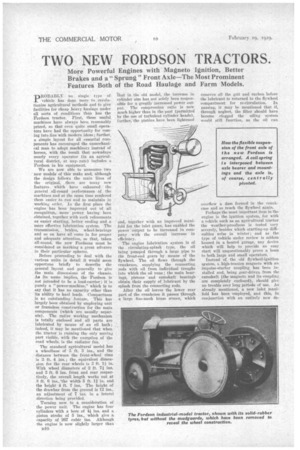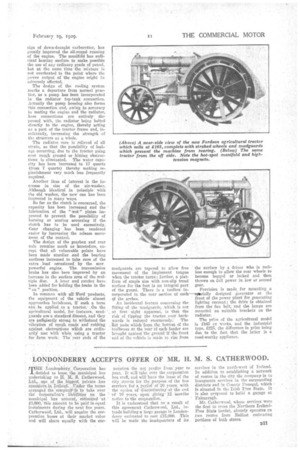TWO NEW FORDSON TRACTORS.
Page 100

Page 101

If you've noticed an error in this article please click here to report it so we can fix it.
More Powerful Engines with Magneto Ignition, Better Brakes and a" Sprung" Front Axle—The Most Prominent Features Both of the Road Haulage and Farm Models.
ROBABLY no single type of vehicle has done more 'to revolu
tionize agricultural methods and to give facilities for cheap heavy haulage under all sorts of conditions than has the Irordson tractor. First, these useful machines have always been reasonably Priced, so that even quite small opera tors have had the opportunity for coming into line with modern ideas ; further, a simple layout for all essential com ponents has encouraged the unmechanical man to adopt machinery instead of horses, with the result that nowadays nearly every operator (in an agricultural district, at anyrate) includes a Fordson in his equipment.
We are now able to announce two new models of this make and, although
the design follows the main lines of the original, there are many new features which have enhanced the general nil-round performance of the machines and at the same time rendered them easier to rim and to maintain in working order. Iii the first place the engine has been improved out of all recognition, more power baying been obtained, together with such refinements as easier starting, better cooling and a more effective lubrication system. The transmission, brakes, wheel-bearings and so on have all 'come in for proper and adequate attention, so that, taken all-round, the new Pordsons must be considered as marking a great advance in their particular spheres. Before proceeding to deal with the various units in detail it would seem opportune briefly to describe the general layout and generally to give the main dimensions of the chassis.
As its name implies, the Fordson is not intended to be a load-carrier ; it is purely a "power-machine," which is to say that it has no capacity other than
its ability to haul loads. Compactness is an outstanding. feature. This has
largely been obtained by employing unit or frameless construction for the main components (which are usually separ ate). The entire working mechanism is totally enclosed and all parts are lubricated by ItlealtH of an oil bath ; indeed, it may be mentioned that when the tractor is mining the only moving part visible, with the exception of the road wheels, is the radiator fan.
The standard agricultural model has a wheelbase of 5 ft. 3 ins., and the distance between the front-wheel rims is 3 ft. 4 ins.; the equivalent dimension for the rear wheels is 3 ft. 1I in.
With wheel diameters of 2 ft. 7f ins.
and 8 ft. 6 ins. front and rear respectively, the overall length works out at 8 ft. 6 ins., the width 5 ft. 11 in. and the height 4 ft. 7 ins. The height of the drawbar from the ground is 12 ins., an adjustment of 7 ins, in a lateral direction being provided.
Turning now to a consideration of the power unit. The engine has four cylinders with a bore of 4f ins, and a piston stroke of 5 ins., whieh give a capacity of 267 cubic ins. Although the engine is now slightly larger than DIO
-that in the old model, the increase in cylinder size has not solely been responsible for a greatly 'increased power output. The compression ratio is now much higher than in the past (permitted by the use of turbulent cylinder heads), further, the pistons have been lightened and, together with an improved manifold for the inlet gases, has enabled the power .ontput to be increased in company with the overall increase in efficiency.
The engine lubrication system is of the circulating-splash type, the oil being pumped through a large pipe to the front-end gears by means of the flywheel. The oil flows through the crankcase, supplying the connecting rods with oil from individual troughs into which the oil runs ; the main bearings, pistons and camshaft bearin6 obtain their supply of lubricant by the splash from the connecting rods.
After the oil leaves the lower rear part of the crankcase it passes through a large fine-mesh brass screen, which removes all the grit and carbon before the lubricant is returned to the flywheel compartment for re-circulation. In passing, it may be mentioned that if, through neglect, the filter should have become clogged the oiling system would still function, as the oil can
overflow a dam formed. in the crankcase and so reach the flywheel again.
Perhaps the most important item in the engine is the ignition system, for with a vehicle such as an agricultural tractor the weather-proofness is tested very severely, besides which starting-lip difficulties arise in winter ; and as the type of vehicle under review is seldom housed in a heated garage, any device which will help to provide an easy start will unquestionably prove a boon to both large and small operators.
Instead of the old flywheel-ignition system, r, high-tension magneto with an impulse-starter _ coupling has been installed and, being gear-driven from the camshaft (the magneto and its-coupling • are completely enclosed), should give no trouble over long periods of use. As already mentioned, a new inlet manifold has been employed, and this, in conjunction with an entirely new de
sign of down-draught carburetter, has greatly improved the all-round running of the engine. The manifold has sueeient heating surface to make possible the use of ani ordinary grade of petrol, but at the same time The mixture is not overheated to the point where the power output of the engine might he adversely affected. The design of the cooling system marks a departure from normal practice, as a pump has been incorporated in the radiator top-tank connection. Actually the pump housing also forms this connection and, owing to accuracy in mating the engine and the radiator, hose connections are entirely disreused with, the radiator being bolted directly to the engine, thereby acting as a part of the tractor frame and, incidentally, increasing the strength of the structure as a whole. The radiator core is relieved of all strain, so that the possibility of leakage occurring, due to the tractor going over rough ground or hitting obstructions. is eliminated. The water capacity has been increased to 17 quarts (from 7 quarts) thereby making replenishment very mtich less frequently required. Another item of interest is the increase in size of the air-washer. Although identical in principle With the old washer, the -new one has been improved in many ways. So far as the clutch is concerned, the capacity has been increased and the lubrication of the "wet" " plates improved to prevent the possibility of burning or scoring occurring if the clutch has to be used excessively. C ear changing has been rendered easier by increasing, the release movement of the control. The design of the gearbox and rear axle remains much as heretofore, except that all vulnerable points have been made sturdier and the bearing surfaces increased to take .care of the extra load occasioned. by the mor, powerful engine. The transmission brake has also been improved by an increase in the surface area of the mul tiple disc. A lever and ratchet have been added for holding the Intake in the
"
on" position. on" position.
In common withall Ford products, the equipment of the vehicle almost approaches lavishness, if such a term
eau' ,be applied to tractor; On the agricultural Model, for instance, mudguards are a standard fitment, and they are suffic,lently strong to withstand the vibration of reugh. roads' and rubbingagainst obstructions which are ordinal-HY° Met .with i "vIen. :using a tractor for farm work. The rear ends of the mudguards are tapered to allow free movement of the implement tongue when the tractor turns; further, a platform of ample size with non-slip tread surface for the foot is an integral part of the guard. There is a toolbox incorporated in the rear section of each-qf the arches. An incidental feature concerning the fitting of -the mudguards, .which is not ' at first • sight apparent, is -that the risk of tipping the tractor over baCkwards is reduced enormously.' The _fiat pads Whichlorm the, bottom of the toolboxes at the "rear 'of each fender are brought against 'the ground 'if' the front end -of the vehicle is made to rise from
• the surface by a driver who is reek' less enough to allow the rear wheels to
• become bogged 07 locked and then throws on full power in low or second gear. Provision is made, for mounting a --eeseially designed generator at the front of the power plant far .generating lighting current; the drife is obtained from the fan belt, and the lamps are :mounted on suitable brackets on the -radiator. The price of the agricultural model is 1165 ex works. -and the industrial type, 1225, the difference in Trice being due to the fact that the latter is a road-worthy appliance.




























































































































































































































